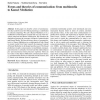Free Online Productivity Tools
i2Speak
i2Symbol
i2OCR
iTex2Img
iWeb2Print
iWeb2Shot
i2Type
iPdf2Split
iPdf2Merge
i2Bopomofo
i2Arabic
i2Style
i2Image
i2PDF
iLatex2Rtf
Sci2ools
MMS
2006
2006
Forms and theories of communication: from multimedia to Kansei Mediation
Abstract In this paper we describe a form of communication that could be used for lifelong learning as contribution to cultural computing. We call it Kansei Mediation. It is a multimedia communication concept that can cope with nonverbal, emotional and Kansei information. We introduce the distinction between the concepts of Kansei Communication and Kansei Media. We then develop a theory of communication (i.e. Kansei Mediation) as a combination of both. Based on recent results from brain research the proposed concept of Kansei Mediation is developed and discussed. The biased preference towards consciousness in established communication theories is critically reviewed and the relationship to pre- and unconscious brain processes explored. There are two tenets of the Kansei Mediation communication theory: (1) communication based on connected unconciousness, and (2) Satori as the ultimate form of experience. Keywords Kansei Mediation
| Added | 14 Dec 2010 |
| Updated | 14 Dec 2010 |
| Type | Journal |
| Year | 2006 |
| Where | MMS |
| Authors | Ryohei Nakatsu, Matthias Rauterberg, Ben Salem |
Comments (0)

